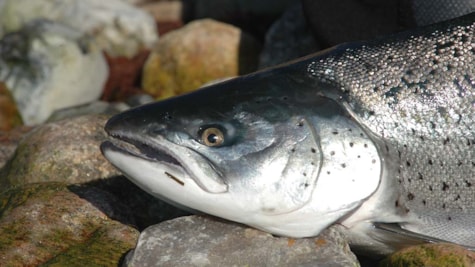Sea trout
Distance: 76.10 Km
The sea trout is hatched in fresh water, where it stays for approx. 2 years. It then swims out into the sea, where in 1,5 years it grows from 20-25 cm. to 40-50 cm. After 1-3 years in salt water, it searches in the summer and autumn for the creek or stream of its childhood to spawn. Some fish stay in salt water and are called 'greenlanders' or 'skippers'. The rest move out into the sea again in December and January after spawning, but not all survive the spawning. In April-June, virtually all adult fish are on the coast.
We divide the gear into 3 categories, where spin fishing is most common, fly fishing has grown explosively in the last 10-15 years and finally bulldozer / bombarda raft fishing, which combines spinning equipment with flies at the end of the line.
Spin fishing
For spin fishing, use an 8-10 foot spinning rod with a casting weight of 5-30 grams. A fixed spool reel with min. 150 meters of 0,25 m/m nylon or 0,12-0,15 m/m braided line is best. Make sure the line spool is filled to the brim. Some use smaller multiplier wheels, which are especially good for the heaviest inshore baits. Coastal flashes and coastal wobblers from 5-25 grams are fine, as they are made for the purpose. The smallest flashes are typically used in calm and clear weather and on flat stretches, while the large flashes and wobblers are used in rougher weather and when there are waves. Colors on flashers and wobblers often engage the anglers more than the fish, but muted colors generally catch best. Silver/green and silver/blue are often used in the spring, while silver/red/orange or copper/red/orange often take fish in the fall. All-white flashes catch all year round, but can be particularly good in winter together with smaller baits in hot colours, typically fluo-orange, red or pink. No rule without exception. The others do not catch anything with e.g. silver flashes, try something else. See photos / links.
Some use them, others do not. A hanging fly tied in a silent approx. 30-40 cm in front of the flash can be very toxic, and used properly, the fly will nearly double your catches measured over the year. Some days the fly takes the vast majority of fish, while the blink may be quite superior other days.
Sea trout can be fished almost anywhere. In this guide, we have selected some good places for you, and all the places throw a lot of fish off each year. Typically, you fish the shore off by taking a cast and spinning in. Walk a few meters and repeat throws and spins in, etc. Be mobile. Get some water covered. If there is a bite, stay in the area because there are often several fish in the same place. The sea trout move along the coast and therefore one has to move to find them. The spinning must be varied so that the flash is spun alternately quickly and slowly. In winter slower. In the summer faster. But no rule without exception. The only rule that applies is that it is the flash or the fly in the water that catches.
Fly fishing
A fly rod of 9-10 feet and aftm 6-8 is fine. It is often windy, so lighter rods dove only in calm weather. A floating line either as a weight forward (WF) or shooting head is best and preferably with a 100 meter backline. The flywheel should preferably be salt water resistant, but still rinse it every day after use in fresh water. Otherwise it corrodes lightning fast and salt water is hard on the gear.
A tapered catch of 3-5 meters with a tip of 0,25 m / m nylon or floucarbon. Use short prey in windy weather and long prey in calm weather so you can control your casts and your fishing. Different flies in sizes 4-10 that look like shrimp and crustaceans are fine. Especially sand-colored shrimp flies are fine, but bring a few black, white and furiously colored ones. The pink 'Pattegris' has become a classic in a few years, but also Kobberbassen, Magnus, Red Tag Palmer, Flash 9 and Honey Shrimp catch lots of sea trout. A mica shrimp in early spring is a safe fly and especially Greenlanders can rarely let it go. See photos / links.
You must be able to throw a minimum of 18 meters, preferably longer. If you can do it, then it's on. The fly is fished by taking 20-40 cm. line ind. Break. Take the line in. Pause, etc. Occasionally, the fly must have a lot of speed. Take the rod under the arm and take in the line at lightning speed. Experiment and vary your intake. Remember a line basket to have around your waist, it makes your fishing much easier and your casts much longer. Ask in the tackle shops / links.
Fishing with bulldo float / bombarda float
Use your spinning rod or buy a longer, specialized 10-12 foot rod with casting weight up to 30 grams. Put a buldo float or bombarda float on the line, typically intermediate of 25 grams. About 3-4 meters from the raft, a fly is tied on a nylon or fluorocarbon line of 0,25 m/m. Throw out. Tighten the line. Spin a turn on the wheel. Count to 3. Spin one turn on the wheel. Count to 5. Etc. Some days it has to go a little faster and other days the fish prefer an even and slow spin-in. If you have never caught a sea trout, buldo/bombarda fishing is probably the fastest way to a sea trout. Try setting a hook with a herring fillet, a few good earthworms or fresh shrimp instead of the fly if you see sea trout that won't take.
Updated by: VisitMiddelfart | mail@visitmiddelfart.dk
